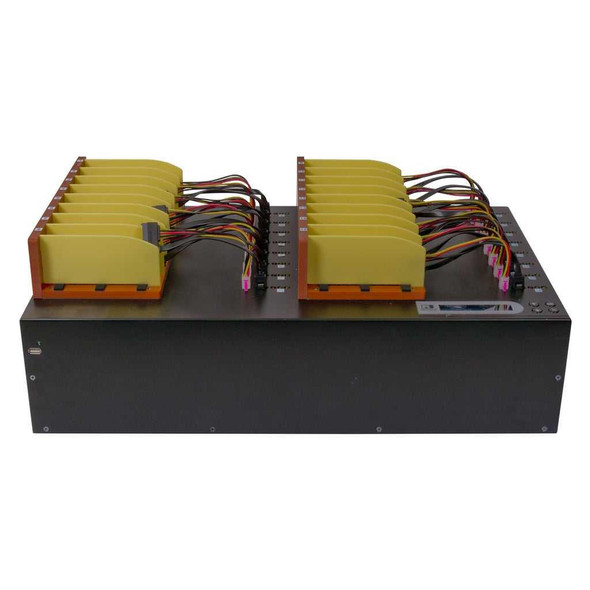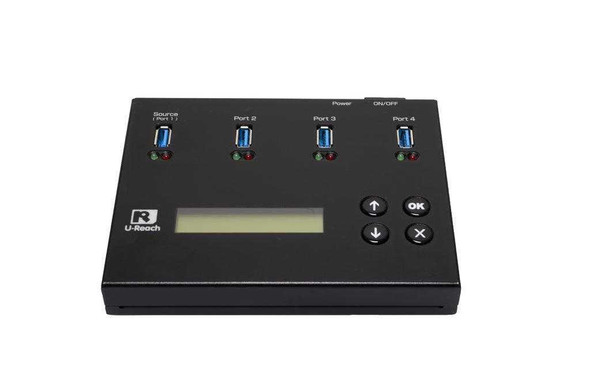Description
The Intelligent U3 Series Duplicator and Sanitizer: Flawless Media Duplication with High-Speed Performance
The Intelligent U3 Series duplicator was meticulously designed with diversified media compatibility and high-speed performance in mind. It not only flawlessly duplicates in high-speed demands but also provides helpful examinations by delivering the most accurate testing functions known today. With its user-friendly interface, this duplicator offers stress-free operation without a steep learning curve. One of its standout features is the Event Log Report, which serves as an essential tool for production quality remote control and yield analysis.
Features
- Standalone operation: No PC required to operate the duplicator.
- Wide compatibility: Compatible with USB 2.0/3.0/3.1/3.2 devices and external USB HDDs.
- High-speed performance: Speeds up to 10 GB/min.
- Support for all data formats: Supports all types of data format copying while performing bit-for-bit duplication.
- Quick copy for Linux and NTFS: Supports "quick copy" for Linux (ext2/ext3/ext4) and NTFS, FAT16/32 file systems.
- Large capacity support: Supports 3TB and above capacity for external USB HDDs.
- Support for eUSB (USB-DOM): Supports eUSB(USB-DOM) 2.54mm and 2.00mm (via adapter).
- MD5 hash calculation: Calculates the MD5 hash of the entire drive, allowing users to quickly verify the source data integrity.
- Log report management: Integrates a log report management system for easy record-keeping.
Intelligent Copy Option
- Systems and Files (Quick Copy Mode)
The U3 Series duplicator offers the Systems and Files (Quick Copy Mode), which automatically copies only the data area, reducing the duration of the copy process. This mode supports various file formats, including Windows (FAT16/32/64/NTFS), Linux (ext2/ext3/ext4), and Mac (HFS/HFS+/HFSX). In case the file system format is not supported, the duplicator will automatically switch to the "whole media copy" mode. - Whole Media Copy Mode
In the Whole Media Copy Mode, the U3 Series duplicator copies from the initial sector to the end, bit-by-bit. This mode does not impose any format limitations, ensuring that all data is duplicated accurately. It is suitable for scenarios where you need an exact replica of the original media. - Intelligent Copy Modes
During the duplication process, the U3 Series duplicator intelligently marks the areas containing data in blue and the areas being copied in red. The actual copying time depends on the speed supported by the device, ensuring efficient and accurate duplication.
Impeccable High Speed
The U-Reach USB drive duplicator, part of the U3 Series, can copy up to 2GB/min on all devices simultaneously. Even with an increased number of targets, the U3 Series duplicator maintains impeccable high-speed performance, ensuring efficient duplication without any speed degradation.
Support for Various USB Devices
Thanks to its unique redundant power design, the U3 Series duplicator offers high compatibilities with various USB devices. Whether it's USB 2.0/3.0 external USB hard drives, MP3 players, or other special media with sufficient power supplies, the U3 Series duplicator can handle them with ease.
Event Log Report for Production Quality Control
The Event Log Report is an indispensable tool for production quality remote control and yield analysis. It records the operation time and result of the duplicator, providing crucial information for quality control purposes. Additionally, it records system and target information details, including VID/PID, MID/OID, and S/N number, for comprehensive recordkeeping.
Technical Specs
| Intelligent U3 USB 3.0 Duplicator & Tester: | ||||||||
|---|---|---|---|---|---|---|---|---|
| Specification: | ||||||||
| Maximum Transfer Speed: | 10GB/min. Actual performance is dependent on device transfer speeds. | |||||||
| Capacity: | Supports the largest sized devices available on the market. | |||||||
| Operation Type: | Stand-alone, FPGA-based operation (Non-PC based) | |||||||
| Language Support: | English or Japanese | |||||||
| LCD Display: | Backlit Monochrome LCD Display | |||||||
| Status LED: | 2 LED Indicators (1 Red/ 1 Green) per Port | |||||||
| Control Panel: | 4 push buttons (up, down, OK, ESC) | |||||||
| Features: | Copy Modes: | Quick Copy (Systems & Files): Supports Windows, Mac and Linux. Whole Media Copy: Copies bit-by-bit regardless of format and data type. |
||||||
| Compare Function | Bit-by-bit data comparison | |||||||
| Sanitization Modes: | Quick Erase, Full Erase, and DoD Erase | |||||||
| Compatibility: | ||||||||
| Compatible Devices: | USB1.1/2.0/3.0/3.1/3.2 devices and USB-HDDs | |||||||
| Compatible Devices (with required adapter): | eUSB (USB DOM) 2.54mm and 2.00mm | |||||||
| Supported O/S: | All (Windows, Mac, Linux, and other stand-alone systems) | Supported Formats: |
|
|||||
| Hardware Specifications: | Working Temperature: | 5°C ~ 45°C (41°F ~ 113°F) | ||||||
| Storage Temperature: | -20°C ~ 85°C (-4°F ~ 185°F) | |||||||
| Working Humidity: | 20% ~ 80% | |||||||
| Storage Humidity: | 5% ~ 95% | |||||||
| Certifications: | FCC, CE, RoHS, MIL-STD810H | |||||||
| Power Supply: |
Power Adapter Input: 100-240VAC / 47-63Hz / 1.6A Max. Power Adapter Output: 12VDC / 9A for UB910U3 (10-Ports) Power Adapter Output: 12VDC / 12.5A for UB9XXU3 (20-Ports and Higher) Each USB 3.0 Port supports up to 2A |
|||||||

















